The Men and Women Fighting America’s Wildfires
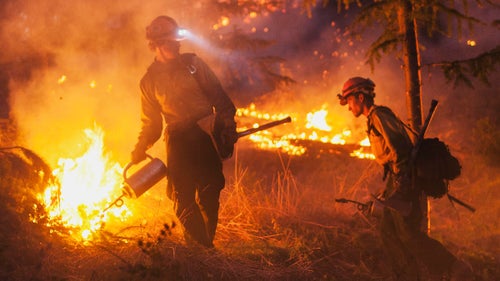
Early in the summer of 2012, I was in the middle of a move from New York City to Boulder. As my plane approached Denver International Airport, I heard gasps from passengers looking out the windows toward the mountains. A harsh red streak outlined the ridgetops, and black plumes of smoke rose into large pyrocumulus clouds. I’d seen tornados, earthquakes, hurricanes, and floods, but never a wildfire.
I spent the rest of that summer watching a parade of trucks roll through the streets surrounding Boulder. The ash-covered faces of firefighters were glued to the windows. Many looked young. All looked tired. When I turned on the news, I saw heartbreaking stories of damage, destruction, and displaced citizens. But I never saw footage of those faces endlessly driving by my house. At the end of fire season, I began a multiyear process of gaining the necessary access to tell the stories of the men and women who work countless hours to put out the fires.
Beginning in 2014, in cooperation with the U.S. Forest Service, I immersed myself with Wildland Fire Incident Command Teams throughout the country. I slept in tents, on the grass, and in trucks with the many different units responsible for fire abatement, from the glamorous hotshots to the unsung radio dispatchers. Fires are remembered by the scope and scale of their destruction. My goal was to show the army that stopped them.
Photo: Two Roosevelt Hotshots, from the Roosevelt National Forest in Colorado, conducting a burn operation at the Happy Camp Fire Complex (2014) in California.
Photos and words from Aaron Colussi.

Hotshot crews at twilight on the Happy Camp Fire Complex in the Klamath National Forest, Northern California. In a burn operation, firefighters start a fire to increase the width of a fire line, creating a buffer between the flames and unburnt ground. This particular burn created a vacuum, sending flames to the main fire (a few hundred yards to the right of frame), which created a fire line of a few hundred yards. Days after this burn, large wind gusts pushed embers over that line and into the forest behind the camera, igniting a new area.
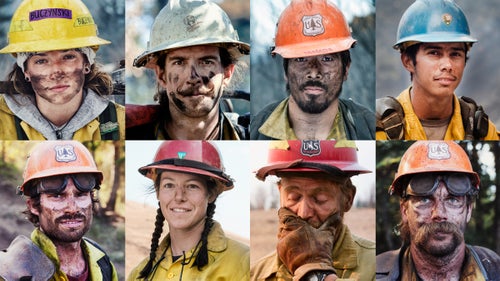
During my coverage, I talked to and photographed dozens of firefighters, some of whose names I was able to get, and some I missed in the heat of the moment.
Clockwise from top left: an AmeriCorps member working her first prescribed burn outside of Estes Park Colorado; firefighter at the Pioneer Fire in Idaho; Roosevelt Hotshot Yuzu Yamada at the Eightmile Fire in Colorado; Eric, from the Arrowhead Hotshots out of King’s Canyon National Park, California; Roosevelt Hotshot Josh Ross at the Happy Camp Complex in California; firefighter Melody Fontaine, from Shoshone National Forest, at the Hunter Peak Fire in Wyoming; a firefighter from the Bighorn Basin at the Hunter Peak Fire in Wyoming; Roosevelt Hotshot Thomas Partipilo at the Happy Camp Fire Complex in California.
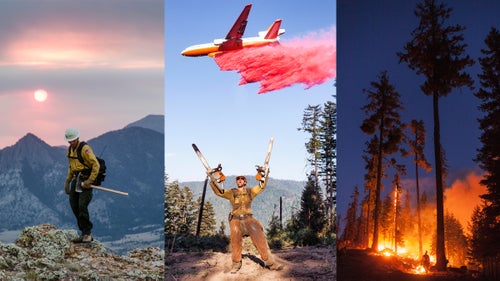
Left: Public information officer Kale Kasey, my media escort at the Hunter Peak Fire (2016) in East Yellowstone, Wyoming, walking a ridgeline. Vast amounts of smoke from this summer’s fires created wild sunsets. Center: A Roosevelt Hotshot having fun during a quick break at the Happy Camp Fire Complex in California. A large DC10 plane dumps retardant on the edge of a bulldozer line. Moments after this photo was taken, I was completely covered in pink. Right: A burn operation at the Happy Camp Fire Complex in California. Burn operations can be very dangerous depending on the type of trees in the forest. A tree in the middle of the frame ignited and created a large flaming spire.
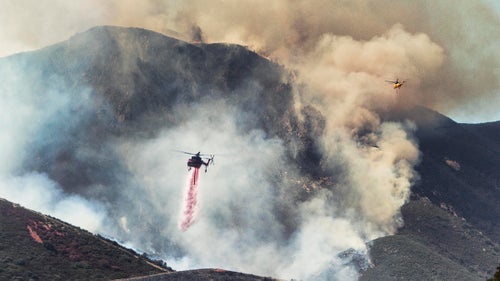
Helicopter cranes dump retardant on the Soberanes Fire (2016) in California’s Los Padres National Forest.

A cockpit view of a retardant drop on the Soberanes Fire in California. The long hose can draw in more than 2,000 gallons of retardant or water in approximately 30 seconds. In an area with a severe water shortage, tankers filled with water to supply the helicopters come from far away.
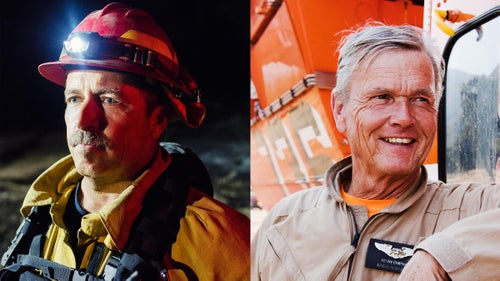
Left: Firefighter Steve Welch, from the Orange Country Fire Authority, on night-shift duty at the Soberanes Fire. Local and city firefighters are brought in to help on fires this large. Additional personnel from AmeriCorps, the California Conservation Corps, the National Guard, and the Marines will be brought in if needed. Right: Helicopter pilot Kenny Chapman at the Soberanes Fire. A pilot for more than 30 years, Chapman has lost count of how many fires he has worked.

The Soberanes Fire at night. What began as an ember from an illegal campfire near Salinas turned into the most expensive fire in U.S. history, costing more than $210 million. At its peak, the fire was assigned more than 5,000 personnel, in part because of its proximity to the Monterey Peninsula and California wine country.
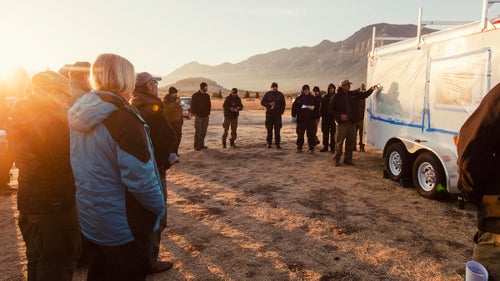
Morning briefing at the Hunter Peak Fire (2016) in Wyoming. No matter the fire’s scale, morning and evening briefings are conducted each day to give the crews and overhead staff information on what the next 24 hours will bring for each unit. Weather shifts on a fire can alter plans instantly, so communication between crews in tents and on the line is essential.
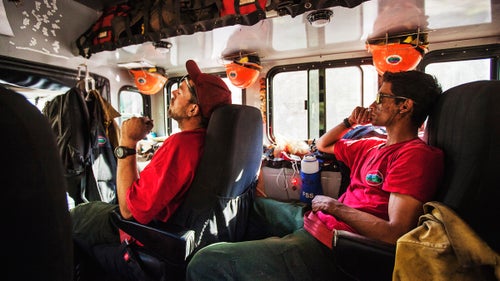
A look inside a Roosevelt Hotshot buggy at the Eightmile Fire (2014) in Colorado. These buggies become a home away from home for the crews during fire season.